Park Sanssouci is a former royal park in Potsdam. The park is home to several palaces and pavilions that were built for King Frederick the Great of Prussia. The most famous among these is the Sanssouci Palace.
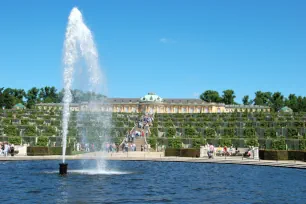
The Sanssouci Park was originally an orchard near Potsdam. This was the favorite retreat of King Frederick the Great. Here he could stay without worries (hence the name sans souci, French for ‘without worries’). No women were allowed in Sanssouci, not even the king’s wife.
Sanssouci Palace
In 1744 the king commissioned architect Georg Wenzeslaus von Knobelsdorff to build a summer palace, the Schloss Sanssouci (Sanssouci Palace). Here, he could leave all the formalities of the royal court behind and spend time on his hobbies like music and philosophy. In the Marmorsaal, which was loosely based on the Pantheon in Rome, he would invite famous philosophers like Voltaire.
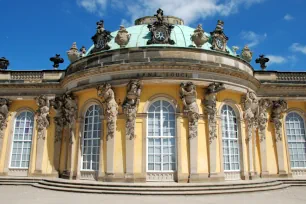
The design of the Sanssouci Palace was based on sketches made by Frederick the Great himself. The relatively small palace with only twelve rooms was completed in 1747. It is located on top of a terraced vineyard, known as the Weinberg (Wine Mountain). The palace is only one story high, but beautifully decorated in Rococo style.
The most eye-catching room is the aforementioned Marmorsaal (Marble Hall), a circular domed room with marble walls and huge Corinthian columns. Other notable rooms include the equally opulent Konzertsaal (Concert Room) and the Bibliothek (library), where Frederick held his collection of about two thousand books, most of them in French, then the lingua franca of the royals.
More sights in Sanssouci Park
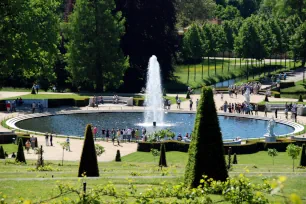
The current layout of the park can be traced back to the nineteenth century, when it was remodeled by the famous Prussian landscape architect Peter Joseph Lenné. The 700-acre / 287-hectare large park consists of several different gardens, all with their own character. It is intersected by a wide lane, the Hauptallee, which runs from an eastern entrance all the way towards the Neues Palais on the west side of the park, a distance of two kilometers (1.2 mi).
The park contains many statues and fountains. The largest fountain is the Große Fontäne (Great Fountain) on the Hauptallee in front of the vineyard, which has a jet that propulses water up to 18 meters high (59 ft).
New Palace
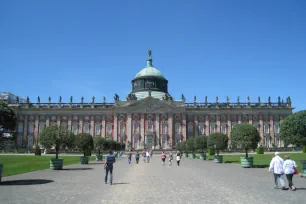
But the most interesting sights in the Sanssouci Park are its many magnificent buildings. The most impressive of all is the Neues Palais (New Palace), a large Baroque palace. It was commissioned by Frederick the Great in 1750, but construction only started in 1763 after the Seven Years’ War, which solidified Prussia’s status as a powerful nation.
The Neues Palais is one of Prussia’s most impressive palaces; in contrast to the Sanssouci Palace, which is rather modest in size, the imposing sumptuous palace contains more than two hundred lavishly decorated rooms spread over two stories.
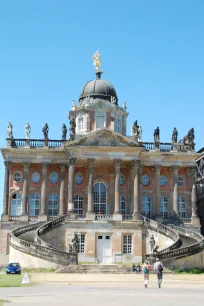
There are several ballrooms, one of which – the Marmorsaal (Marble Hall) – has a magnificent ceiling fresco of ‘The Induction of Ganymede in Olympus’, the largest ceiling canvas painting north of the Alps. But the most remarkable room is the Grottensaal (Grotto Hall) on the ground floor, its walls completely covered with semi-precious stones and shells that form images of mythical animals.
Opposite the Neues Palais are the Communs, two magnificent Rococo buildings joined together by a curved colonnade. Despite their palatial appearance, they contained the servants’ quarters and palace kitchens.
Bildergalerie & Neue Kammern
Two one-story buildings flank the Sanssouci Palace on either side. The one on the left is the Neue Kammern, a pavilion that was originally built in 1745-1747 as an orangery. It was designed by Georg Wenzeslaus von Knobelsdorff in the Rococo style, although its exterior is quite subdued. The pavilion was later converted into a guesthouse, hence its name Neue Kammern (New Chambers).
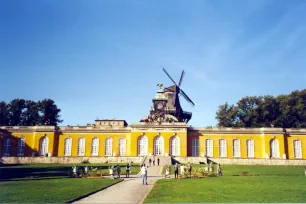
Behind the Neue Kammern, just outside the park’s border, is the Mühle, a functioning replica of an eighteenth-century windmill, which sits just east of the Sanssouci Palace.
The Neue Kammern is nicely complemented by the Bildergalerie (Painting Gallery) on the right-hand side of the Sanssouci Palace. The gallery was built in 1764 to house the art collection of Frederick the Great. Today it is a museum with a collection of paintings from masters such as Rubens, van Dyck and Caravaggio.
Orangerie
One of the most impressive buildings in Sanssouci is the Orangerie, a 300 meter (984 ft) long structure whose design was inspired by Renaissance-style villas that Frederick William IV had seen during his travels through Italy. It was built between 1851 and 1864 as an orangery, and it is still partly used as such. Other rooms house a collection of paintings by Raphael. They are nineteenth-century copies, the originals were looted by Napoleon.
Chinese Teahouse
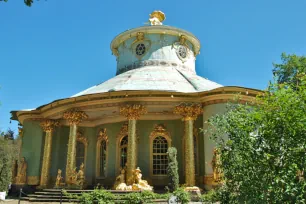
There are also some eccentric buildings on the grounds of the Sanssouci Park, which show the royals’ affinity for exotic architectural styles. The most eye-catching is the Chinesisches Teehaus (Chinese teahouse), an oriental style teahouse constructed in 1756. It currently houses a collection of porcelain. In front of the pavilion sit a number of gilded statues that depict tea-sipping and music-playing Chinese figures.
Only four years after the completion of the teahouse, Frederick the Great commissioned the construction of yet another oriental style building: the Drachenhaus (Dragon House). The pavilion, which resembles a pagoda, is named after the dragon statues that adorn the roof of the ground floor.
Nearby the Dragon house is the Belvedere auf dem Klausberg, yet another pavilion. It was built in 1770-1772, at the same time as the Dragon House, but this pavilion was built in the more customary classical style.
Church of Peace
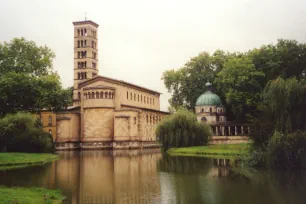
The Friedenskirche (Church of Peace), in the south-east corner of the Sanssouci Park, was built between 1845 and 1854 for King Frederick William IV. Its interior was designed after the San Clemente church in Rome. The church contains the tombs of the king and his wife, Elisabeth Ludovika of Bavaria.
Park Sanssouci borders the city center of Potsdam, which can be reached from Berlin via S-Bahn no. 7.

